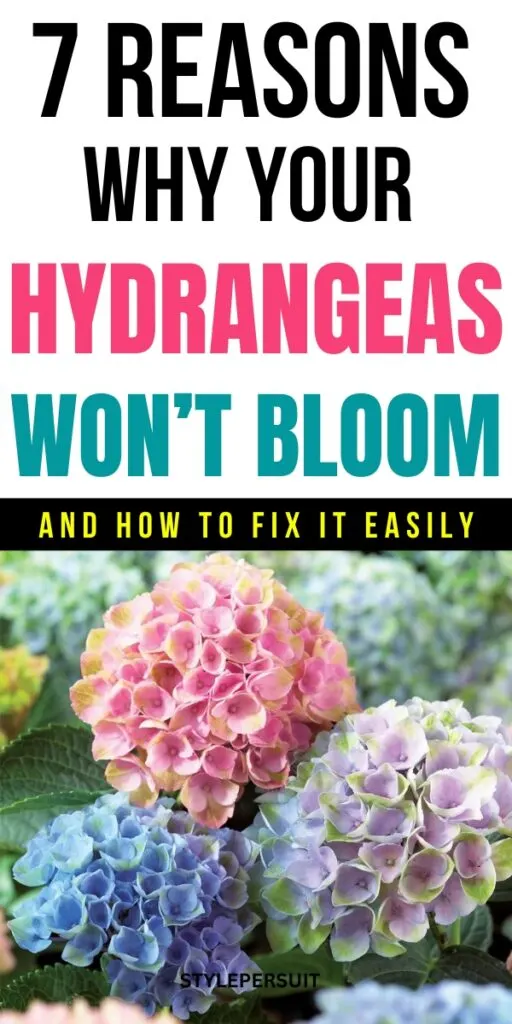Hydrangeas are like that friend who always looks amazing but needs the exact right lighting, mood, and playlist to actually show up to the party.
You feed them, water them, even whisper sweet nothings to their stems, and still, not a single bloom.
So what’s going on?
If your hydrangeas are all leaves and no flowers, don’t panic. You’re not alone.
Here’s a breakdown of the most common (and fixable) reasons your hydrangeas aren’t blooming, and how to turn that green frustration into a full-on floral show.

1. You Pruned at the Wrong Time
Hydrangeas aren’t “one-size-fits-all.” Some bloom on old wood (last year’s growth), others on new wood (this year’s stems).
If you prune at the wrong time, you’re literally cutting off the flower buds.
Old wood bloomers: Bigleaf (macrophylla), Oakleaf, and Climbing hydrangeas
New wood bloomers: Panicle (paniculata) and Smooth (arborescens)
Fix it: Know your type. For old wood bloomers, prune right after they flower, not in spring. New wood types? You can cut them back in late winter with no guilt.
2. Not Enough Sun
Hydrangeas like dappled light, not deep shade. They’re not fans of full, harsh sunlight either.
But give them too little sun, and they’ll just sit there, pretty green leaves, no blooms, like an understudy who never gets the spotlight.
Fix it: Aim for morning sun and afternoon shade, especially in warmer regions. Eastern exposure tends to work beautifully.
If your hydrangeas are buried under thick tree canopies or stuck on the north side of your house, consider transplanting them in fall when the weather’s cooler.
Or, prune nearby trees and shrubs just enough to let in a few golden rays without roasting them.
3. Too Much Nitrogen, Not Enough Phosphorus
If your hydrangea is leafy, lush, and bloom-free, it’s probably overdosed on nitrogen. It’s like giving someone only protein shakes and wondering why they don’t smile.
Nitrogen promotes leafy growth, which is great, until it hijacks the whole show and forgets the flowers.
Hydrangeas need phosphorus to bloom, plain and simple. If the soil lacks it, your plant will focus on foliage, not blossoms.
Fix it: Use a balanced or bloom-boosting fertilizer (look for a higher middle number—like 10-20-10 on the label). These numbers refer to nitrogen (N), phosphorus (P), and potassium (K).
You can also toss in a bit of bone meal or rock phosphate to gently boost phosphorus without overwhelming the plant.
Don’t fertilize too often; once every 4–6 weeks during the growing season is usually plenty.
4. They’re Too Young or Just Stressed

First-year hydrangeas (or those recently moved) are like new roommates, still adjusting.
They’re trying to make sense of their surroundings, put down roots (literally), and get comfortable before showing off.
Shock from transplanting, sudden changes in sun or soil, or inconsistent watering can all delay blooming. Sometimes they skip a season while they regroup.
Fix it: Be patient. Water consistently, mulch around the base to keep the roots cool and moist, and give them a full growing season to settle in.
No drama, just steady support, your hydrangea will come around when it’s ready.
5. Wrong Type for Your Zone
Some varieties, like Bigleaf hydrangeas (Hydrangea macrophylla), are a bit too delicate for colder zones.
They form buds on old wood, meaning last season’s growth. If winter temperatures dip too low, those buds get zapped before they ever get a chance to bloom.
So spring comes… and nothing happens.
Even a mild late freeze can do damage. And if you live in USDA zones 5 or lower, Bigleaf types can be downright moody.
Fix it: Choose cold-hardy varieties that bloom on new wood. Smooth hydrangeas (like Annabelle) and Panicle types (like Limelight, Little Lime, or Quick Fire) are more reliable bloomers, even after harsh winters.
They reset each year and don’t rely on last year’s growth, making them much easier to manage in chillier climates.
6. Late Frost Wiped Out the Buds
One rogue frost can kill early buds, especially on old wood varieties. These plants form their buds in the previous season, so a chilly surprise in late spring can undo months of quiet growth.
You’ll see green leaves later, but no flowers, like a tree that missed the memo about spring.
Fix it: If frost is common in your area, keep an eye on the forecast in spring and be ready to act fast.
Drape your hydrangeas with an old sheet, burlap, or frost cloth during cold snaps to protect vulnerable buds.
Anchor the edges with rocks or bricks to stop the wind from undoing your good intentions.
It’s a bit of work, sure, but totally worth it if it means those dreamy blooms actually show up.
7. Soil pH Is Out of Whack
You’ve probably heard that pH affects flower color, but it can also impact whether blooms appear at all.
If the soil is too acidic or too alkaline for your hydrangea’s needs, it won’t absorb nutrients properly.
Fix it: Test your soil pH (you can get a kit at any garden center). Most hydrangeas like a slightly acidic pH between 5.5 and 6.5.
Amend the soil gradually with lime (to raise pH) or sulfur (to lower it), depending on your plant’s needs.
Final Thoughts
Hydrangeas keep us humble. They’re beautiful, dramatic, and totally worth the effort. Once you figure out what’s holding your blooms back, everything changes.
One small tweak, like pruning at the right time or fixing your fertilizer, can turn those green bushes into a bloom-filled centerpiece.
And if you’re wondering about other backyard tricks (like using baking soda for flowering or fungus), don’t miss this guide:
Baking Soda for Hydrangeas: What Works and What Doesn’t
Your hydrangeas will thank you, eventually, in full color.

